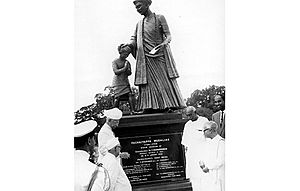Pachaiyappa Mudaliar facts for kids
Vallal Pachaiyappa Mudaliar (1754–1794) was an important merchant and a kind-hearted person from Madras (now Chennai) in the 1700s. He was also a dubash, which was a local agent or interpreter who helped British traders communicate and do business in India. A special stamp was released on March 31, 2010, to honor him.
Quick facts for kids
Vallal
Vallal Pachayappa Mudaliar
|
|
|---|---|
 |
|
| Born |
Pachayappa Mudaliyar
Periyapalayam, North Arcot district, British India
|
| Occupation | Philanthropist, merchant, Dubash |
| Parent(s) | Viswanathan Mudaliar |
Contents
Early Life and Work
Pachaiyappa Mudaliar was born in a village called Periyapalaiyam in the Thiruvallur district. His father was Visvanatha Mudaliar. When he was young, a dubash named Narayana Pillai invited him to Madras.
Pachaiyappa started working as a dubash himself at just 16 years old. By the time he was 21, he had become very wealthy. He was so respected that a poet named Ramanuja Kavirayar even wrote a special collection of poems about him called Pancharatnamala.
Rising to Power
After his mentor, Narayana Pillai, passed away, Pachaiyappa Mudaliar quickly became a leading dubash. At the same time, his employers, the Powney brothers (Henry and Thomas Powney), became the Mayors of Madras. This made Pachaiyappa Mudaliar even more important. He became one of the richest and most powerful people in Madras city.
His Simple Lifestyle
Even though Pachaiyappa Mudaliar was very rich, he lived a simple life. In 1790, he built a house at 26 Pagoda Street, where he lived until he died. People who knew him said he would bathe in the Coovum River every day with his wealthy neighbors. After bathing, he would go to the temple in Komaleeswaranpet to pray.
He often visited the Ekambaranatha Temple in Kanchipuram and paid for its repairs himself. You can even see a statue of him on a pillar in the Kanchi Ekambareswarar temple. To make it easier for people in Chennai to pray, he also built a similar Ekambareswarar temple in Parry's Corner (which was then called George Town). He traveled often between Chennai and Thanjavur and regularly visited his home village, Periyapalayam. On his journeys, he would stop for days in Chidambaram to pray at the famous Hindu temple there.
His Death
Pachaiyappa Mudaliar's health got worse quickly. In 1794, during a trip to Thanjavur, he became very ill in Kumbakonam. He passed away on March 31, 1794, in Tiruvaiyaru.
His Amazing Will
Pachaiyappa Mudaliar was one of the first Indians to leave a will, which is a legal document saying what should happen to his money after he dies. He set aside a huge amount of money, about 450,000 rupees, to be used for Hindu religious places. He left another 700,000 rupees to provide English education for young Hindu people. At the time of his death, his total wealth was estimated to be about 1.7 million rupees!
However, there were some disagreements about his will, and it took a long time for everything to be sorted out. It wasn't until 1909 that a group of trustees was chosen to manage his trust. By the 1990s, the trust was worth over 45 billion rupees, making it one of the largest in that part of the world!
The trust manages religious charities from Kanyakumari in the south to Varanasi in the north. It also runs six colleges, a polytechnic (a school for technical skills), and 16 schools in Tamil Nadu. It has also helped many medical facilities and owns a lot of property in the state.
Pachaiyappa's College
One of the most famous things Pachaiyappa Mudaliar is known for is Pachaiyappa's College. This college started as Pachaiyappa's Central Institution on January 1, 1842. It was funded by the money Pachaiyappa Mudaliar had left for charity in his will.
In 1856, the institution moved to its own building on China Bazaar. It became a school in 1850 and then a full college in 1889. Pachaiyappa's Central Institution was special because it was the first educational institution in South India that was not run by missionaries and was not funded by the British.

